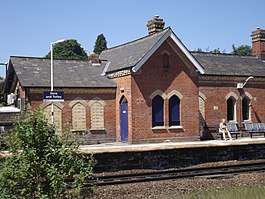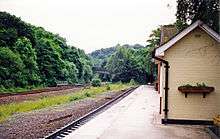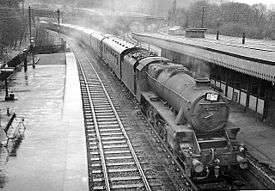Dore and Totley railway station
| Dore and Totley | |
|---|---|
 Dore and Totley railway station | |
| Location | |
| Place | Abbeydale |
| Local authority | City of Sheffield |
| Coordinates | 53°19′39″N 1°30′56″W / 53.327570°N 1.515440°WCoordinates: 53°19′39″N 1°30′56″W / 53.327570°N 1.515440°W |
| Grid reference | SK323812 |
| Operations | |
| Station code | DOR |
| Managed by | Northern |
| Number of platforms | 1 |
| DfT category | F2 |
|
Live arrivals/departures, station information and onward connections from National Rail Enquiries | |
| Annual rail passenger usage* | |
| 2012/13 |
|
| 2013/14 |
|
| 2014/15 |
|
| 2015/16 |
|
| 2016/17 |
|
| Passenger Transport Executive | |
| PTE | Travel South Yorkshire |
| Zone | Sheffield |
| History | |
| Original company | Midland Railway |
| Pre-grouping | Midland Railway |
| Post-grouping | London, Midland and Scottish Railway |
| 1 February 1872 | Opened as Dore and Totley |
| 18 March 1971 | Renamed Dore |
| 2008 | Renamed Dore and Totley |
| National Rail – UK railway stations | |
| * Annual estimated passenger usage based on sales of tickets in stated financial year(s) which end or originate at Dore and Totley from Office of Rail and Road statistics. Methodology may vary year on year. | |
|
| |

Dore and Totley railway station (named Dore railway station from 1971 until 2008) is a small, one platform railway halt near the Sheffield suburbs of Dore and Totley in South Yorkshire, England 4 3⁄4 miles (7.6 km) south of Sheffield. The station is served by the Northern service between Sheffield and Manchester, East Midlands Trains service from Liverpool to Norwich and the TransPennine Express service between Manchester and Cleethorpes, all three running via the Hope Valley Line.
History
The station was opened by the Midland Railway, for passengers only, as Dore and Totley on 1 February 1872[1] (at a building cost of £1517 and £450 for 2 acres (8,100 m2) of land) on the then two-year-old Midland Main Line extension from Chesterfield to Sheffield, and was initially served by the local services on this line. The station was then served by six or seven weekday trains and three on Sundays.
In 1894 the station became the junction for the new Dore and Chinley line (now the Hope Valley Line). Dore & Totley Station Junction was at the south end of the station and the signal box stood in the angle between the Chesterfield and Chinley lines.[2]
Between 1901 and 1902, the line between Sheffield station and Dore was widened; the original twin tracks continued to be used by traffic for the Dore and Chinley line and two new tracks were built to the east of this for traffic on the main line to Chesterfield.[3] The original southbound platform was converted to an island platform and a new platform for trains to Chesterfield built to the east. The line from Chesterfield was slewed into its present course to serve the new platforms. A new Dore and Totley Station Junction was made to the north of the station.
On 9 October 1907, a Sheffield to Birmingham and Bristol express train ran foul of the points at the station. One of the locomotives hit the platform and overturned. The driver and the second man were thrown from the cab but survived, and the passenger coaches fortunately stayed upright with no passengers injured.
Dore and Totley became south Sheffield's only remaining station after the Beeching cuts in the 1960s saw Beauchief, Millhouses and Heeley stations all close. The station was closed to main line traffic and became an unstaffed halt in 1969. It was renamed Dore on 18 March 1971.[1] Subsequently, the island and eastern platforms were demolished in the mid-1980s. Mainline services from the South therefore can no longer stop at the station and the Hope Valley Line now runs single-track (it was singled in March 1985) through the station, with trains in both directions stopping at the one remaining platform. The photograph (right) is taken from the South and shows the remaining platform on the Hope Valley line and none on the main line.
The single-track section through the station has become a significant bottleneck, as noted in Network Rail's Yorkshire and Humber Route Utilisation Strategy of 2009. The strategy included proposals to address the problem by re-doubling the track and building a second platform (subject to funding being obtained). South Yorkshire Passenger Transport Executive has also been lobbying for this problem to be addressed (as noted in its 2006 Rail Strategy document[4]).
The station site had previously been occupied by the Walk Mill; a water-powered mill in operation from the 1280s onwards was used by the monks of Beauchief Abbey to cleanse and thicken cloth.
The name Dore and Totley was restored in April 2008 when the station received new Northern Rail branded running in boards. Plans are being drawn up to double the size of the station by 2014. An additional platform and new Disability Discrimination Act 1995-compliant footbridge are to be provided.[5] Construction work began in December 2012 on a new 100-space car-park, which was completed in April 2013.
Network Rail's Hope Valley Capacity Scheme includes plans to restore the second platform at Dore & Totley. Plans include a new bridge with passenger lifts and a shelter on the single sided island platform for Manchester bound trains.[6] This plan is spun out of the original Manchester Hub scheme, now renamed the Northern Hub, incorporating two freight passing loops to be constructed east of Bamford and at Dore South. Once completed an hourly stopping service is hoped to be provided (as stated in the new 2016 Northern franchise agreement),[7] and platforms should be long enough to accommodate 6 car trains, now running on TPE fast services.
The Secretary of State at the Department for Transport approved the Capacity Scheme in February 2018 [8] and Network Rail have indicated an intended start date sometime in 2019 which may allow completion by 2021.
Facilities
The station is unstaffed, but has a self-service ticket machine available. The old station buildings are now in private commercial use as a restaurant.[9] A small brick waiting shelter is provided at the northern end of the platform, along with CIS displays, automatic announcements and timetable poster boards to offer train running information. Step-free access is available from the car park to the platform.[10]
Services

The station has an hourly Northern stopping service in each direction on the Hope Valley line (but with some gaps of 2 hours or more) between Sheffield and Manchester Piccadilly, augmented by a number of peak-hour stops (designed primarily for Manchester bound commuters) by faster trains on the South Trans-Pennine and Liverpool - Norwich routes.[11] During the rest of the day those hourly TransPennine Express services and East Midlands Trains non-stopping trains pass through.
Notes
- 1 2 Butt, R.V.J. (1995). The Directory of Railway Stations. Yeovil: Patrick Stephens Ltd. p. 81. ISBN 1-85260-508-1. R508.
- ↑ OS 1:2500 Second Series Derbyshire sheet XI-12 dated 1898
- ↑ Batty, Stephen (2005). Rail Centres: Sheffield. Nottingham: Booklaw Publications. p. 53. ISBN 1-901945-21-9.
- ↑ SYPTE Rail Strategy 2006 p.38 SYPTE website; Retrieved 25 February 2009
- ↑ Railway Herald issue 221 p. 3 Archived 15 July 2011 at the Wayback Machine. Railway Herald; Retrieved 10 May 2010
- ↑ Hope Valley Capacity Scheme - June 2015 Network Rail website; Retrieved 27 July 2015
- ↑ Northern Franchise Improvements - DfT
- ↑ http://www.fodats.net/hope-valley-decision-letter.pdf
- ↑ "Dore and Totley Station" (2011) Dace, Ashley Geograph.org.uk; Retrieved 30 June 2017
- ↑ Dore & Totley station facilities National Rail Enquiries
- ↑ Table 78 National Rail timetable, May 2017
References
| Wikimedia Commons has media related to Dore and Totley railway station. |
- Peter Fox (1990). The Midland Line in Sheffield. Sheffield: Platform 5 Publishing Ltd. ISBN 1-872524-16-8
- Peter Harvey (1996). Abbeydale and Millhouses. Stround: The Charlford Publishing Company Limited. ISBN 0-7524-0732-5
- Ecclesall Woods Archaeology - Heritage Woods Online.
| Preceding station | Following station | |||
|---|---|---|---|---|
| Northern | ||||
| East Midlands Trains Limited service | ||||
| TransPennine Express South TransPennine Limited services | ||||
| Historical railways | ||||
| Beauchief Line open, station closed |
Midland Railway Midland Main Line |
Dronfield Line and station open | ||